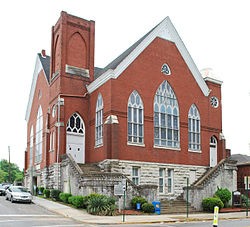Wiley Memorial United Methodist Church
Introduction
Text-to-speech Audio
The lot that the Wiley Memorial United Methodist Church sits on was used by settlers as early as 1835. A log cabin was built on, what what known as Lot 10, which served as a schoolhouse and church. The First Centenary United Methodist Church began using the log cabin in 1842 and bought the land in 1847. They quickly built their own church on the site. In 1863, the Union Army occupied Chattanooga and used the building as a hospital. The building was destroyed by a fire in 1887. The First Centenary United Methodist Church, now called the Wiley Memorial United Methodist Church, has occupied the building since 1889.
Images
Wiley Memorial United Methodist Church

Backstory and Context
Text-to-speech Audio
When the first settler's arrived to the Chattanooga area, they called it Ross's Landing. Ross's Landing had one community building, a log cabin. This cabin was used as both a schoolhouse and a church from 1835 until 1847. In 1847, the city began to sell off all of the land, with the last parcel becoming available being called "Lot 10", the site of the log cabin. This lot was purchased by the Presbyterian Church.
The congregation took down much of the original log cabin and built a church on the site. Construction cost over $3,000. The church became known as the "pepperbox" church because of the square shape of the belfry. The church was used up until 1863, when the Union Army began their occupation of Chattanooga. The Army used the site as a makeshift hospital and part time prison.
After the war, the building was in terrible condition. It is thought that the army tore up much of the building to provide themselves firewood. After the Union occupation, the building was put up for sale. It was purchased by the the First Centenary United Methodist Church, the first independent, African American congregation in Tennessee after the Civil War. Soon after First Centenary began repairs on the building, it was destroyed by arson. In 1887 they rebuilt the church that now stands on the site.
The congregation took down much of the original log cabin and built a church on the site. Construction cost over $3,000. The church became known as the "pepperbox" church because of the square shape of the belfry. The church was used up until 1863, when the Union Army began their occupation of Chattanooga. The Army used the site as a makeshift hospital and part time prison.
After the war, the building was in terrible condition. It is thought that the army tore up much of the building to provide themselves firewood. After the Union occupation, the building was put up for sale. It was purchased by the the First Centenary United Methodist Church, the first independent, African American congregation in Tennessee after the Civil War. Soon after First Centenary began repairs on the building, it was destroyed by arson. In 1887 they rebuilt the church that now stands on the site.
In 1978, the building was declared unsafe. The congregation raised money to restore the roof and reveal much of the interior woodwork.
